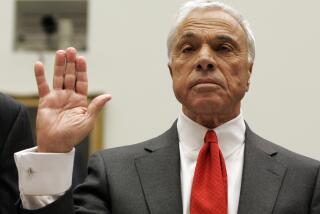Defying a Trend, Commerce Bank Puts Safety First : Finance: The Kansas City, Mo., institution is flourishing while others are failing. The secret is conservative management.
KANSAS CITY, Mo. — Welcome to Commerce Bank, the safest bank in America.
While hundreds of banks around the country are failing each year--threatening a repeat of the savings and loan debacle--this one is flourishing.
Commerce Bancshares, the bank’s parent company, is making record profits after having doubled its earnings during the second half of the 1980s. And the bank itself maintains what analysts say is the cleanest balance sheet in the industry, with one of the fattest levels of capital reserves of any bank in the country.
All this has been enough to earn Commerce Bank the reputation of being as safe as, well, as safe as an old-fashioned bank. In 1989, a survey conducted by United States Banker magazine rated Commerce the “least risky” and “best” bank in America. Last year, Commerce Bank won again.
“I don’t think there is any question that it is the safest bank around,” says Robert Meeder, a Kidder Peabody analyst who follows regional banks. Joseph Stieven, a banking analyst with Stifel, Nicolaus & Co., a St. Louis-based brokerage, agrees. “It would be very difficult to find a more prudent management in banking today,” he says.
Analysts say Commerce’s success shows that despite the long-term economic squeeze that has plunged the industry into its worst crisis since the Great Depression and left the survival of many of the nation’s largest banks in doubt, conservative management practices can still make a critical difference. “If every bank in the country had acted like Commerce, we would still have had a banking crisis, but I think it would be on a much smaller scale,” says Kidder Peabody’s Stieven.
Commerce has kept its health mainly by avoiding the excesses that enticed so many other bankers during the 1970s and 1980s, during an era when the growing competitive pressures on the industry were leading many bankers to take greater risks to maintain their profitability.
The bank can trace much of its style to a deep tradition of sharp-eyed lending practices. In 1893, W. S. Woods, the bank’s founder, gave some advice to his nephew, who was about to set up a bank in Colorado: “I can forgive you almost anything,” he wrote, “but making bad loans.”
Nearly a century later, Woods’ descendants still run his bank--and still remember his cautionary words. Jim Kemper, the patriarch of the family today, just sent a copy of his great-grandfather’s letter to his sons, Jonathan and David, who are now running Commerce, as a reminder of the family’s deeply ingrained tradition of conservative banking. But the Kemper sons, the family’s fifth generation at the helm of Commerce, were already practicing what W. S. Woods preached.
The bank has always been closely linked to the local elite. Missourian Harry S. Truman, for instance, began as a clerk at Commerce Bank, and for decades the bank’s chief credit officer was local leader Arthur Eisenhower, brother of President Dwight D. Eisenhower. Over the generations, those family and community ties have helped Commerce keep its money close to the relatively stable economy of Kansas City--and out of too much trouble far from home.
“My father banked there, and I’ve had an account there since I was a little boy, and they have always been a conservative bank,” says Henry Bloch, chairman of H & R Block and a member of Commerce’s board.
In boom times, of course, the Kempers’ prudence looked much more like tightfisted parochialism. “We’ve been criticized in the past for our lending practices,” David Kemper concedes. “There have been times when people in town didn’t think we were doing enough” in terms of lending for local businesses, he says.
Still, when new fads in risky lending began to develop during the past 20 years, the Kempers did something most bankers seemed unable to do: They just said no.
In the early 1970s when other bankers were rushing to lend to Third World nations, the wary Kempers were pulling out of Mexico. The big New York banks saw Latin governments as guaranteed “sovereign” credit risks who were willing to pay high interest rates. The Kempers saw only trouble. Today, Commerce has only one foreign loan on its books.
Later, the Kempers, who own roughly 12% of Commerce and retain effective control of the $6-billion bank, cut back on agricultural loans early in the farm crisis and stayed out of energy lending; the bank has no oil and gas loans on its books.
More recently, the bank rebuffed repeated attempts by Wall Street investment bankers to get Commerce to help finance junk bonds for risky leveraged buyout deals. Although commercial banks are prohibited from investing directly in junk bonds, many provided other equally risky forms of financing for junk bond dealers that made their leveraged buyouts possible; those loans are coming back to haunt many of the nation’s biggest banks.
But when Wall Streeters approached Commerce, the Kempers weren’t interested. Loans for highly leveraged transactions account for just 0.5% of Commerce’s loan portfolio.
“We would get these Federal Express packages from New York in the morning, offering us a piece of some junk bond deal,” recalls 37-year-old Jonathan Kemper, president of Commerce Bank of Kansas City, a major subsidiary of Commerce Bancshares. “They would say we would have to give them an answer by the afternoon.
“We just decided not to play that game. We just don’t loan money for things we don’t understand.”
Jim Kemper, now 69 and the chairman of Commerce Bancshares, contends that the family’s innate caution has been bolstered by a few bad experiences. “My father lost a ranch to the government down in Mexico in the 1930s, so we never bought this idea that a sovereign government wouldn’t default on its loans,” he says.
David Kemper, the 40-year-old chairman of Commerce Bank of St. Louis, one of Commerce Bancshares’ two main banking operations in Missouri, has similar memories. “I remember my father saying 10 years ago that he never wanted to have to send the Marines in to collect on a loan,” Kemper says. “He was always very suspicious of Third World lending.”
But it wasn’t just Midwestern innocence that kept Commerce out of junk bonds and the like. Both Jonathan and David Kemper started their careers with New York banks before returning home to join their father; David Kemper also served briefly as a federal bank examiner in Manhattan. Both had hard-edged misgivings about the fever that seemed to grip the financial industry in the 1980s.
In 1988, for instance, long before Wall Street woke up to the full dangers of junk bonds, David Kemper wrote a satirical article published in the New Republic magazine, describing how everyone in America could get rich if only the government would agree to a leveraged buyout of the United States. To pay for the deal, he wrote, all we would have to do would be to sell off most of the West to the Japanese and the sultan of Brunei.
Although Commerce lost money on some commercial real estate projects that went bust, the Kempers generally stuck close to Missouri, lending money mainly to people and corporations in Missouri, where they knew enough about business conditions to understand the risks involved in the deals they were financing. And when they did suffer losses on loans, they had more than enough reserves to protect themselves.
“They are the envy of the industry when it comes to how low their loan losses are,” says banking analyst Meeder. “They have kept their loans diversified, and they have kept them with customers in their home market, which they know well.”
Analysts who keep tabs on the bank’s progress believe that the key to Commerce’s success has been that, unlike the managers of many larger banks, Commerce’s owners are also its managers; the Kempers have been willing to keep much of the family’s own money tied up in the bank’s stock.
“The management owns a lot of stock so they are real careful with their money,” notes Ken Puglisi, a regional banking analyst with the New York brokerage Keefe, Bruyette and Woods.
And with the family’s money locked up in Commerce stock, the Kempers tend to stick to the fundamentals of banking.
“You have to keep checking and rechecking everything you do and the loans you make, and it is important to go out and see people, to see how their projects are going,” says Jim Kemper. “It is hard work, but the people who run this bank have a lot of stock in it, and they don’t want to lose their money.”
More to Read
Inside the business of entertainment
The Wide Shot brings you news, analysis and insights on everything from streaming wars to production — and what it all means for the future.
You may occasionally receive promotional content from the Los Angeles Times.










